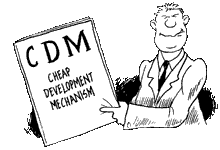|
 |
|
November 20, 2000
Mind that CDM: Discounting the future
 Unclean Development Mechanism Unclean Development Mechanism
Cheap Development Mechanism
Clever Delay Mechanism
Why CDM deserves to be called all this and more...
Climate negotiations have always been like walking in a
landmine-infested area for Southern delegates and civil society in the past. Remember how
we stepped on CDM at Kyoto? We from the South thought we were talking about a clean
development fund until almost the last day of negotiations, an idea we warmed up to
immediately because it was straightforward and simple - polluters would pay into a common
fund for not meeting commitments. But just when we mellowed to the idea, it turned into
that monster of confusion, the clean development mechanism.
 The magical overnight transition was wrought through
the good offices of the US delegation, which always works overtime in the interests of the
American The magical overnight transition was wrought through
the good offices of the US delegation, which always works overtime in the interests of the
American
people - or at least, in the interests of the American people who pay generously into
campaign funds. Tired and overworked Southern delegates found, to their confusion, that
not only had terminology changed but also the concept. This here was no straightforward
polluter pays principle. It was, in fact, a very clever way to drive down the price of
meeting commitments. In the North, this is called economic efficiency. In the South, this
is clever carbon accounting, a way to pass the buck to the poor.
Here’s why:
Bypassing the Poor
There is a strong concern among poorer, less
industrially developed countries that cdm will totally bypass them (see: African delusion). Studies show that if CDM is
restricted to 10 per cent of annex I emissions reduction, at least 80 per cent will be
achieved in China. It should be noted that even India and China will have to compete for
least-cost op tions which will reduce their ability to ensure that climate change
abatement projects address their national priorities in sustainable development. tions which will reduce their ability to ensure that climate change
abatement projects address their national priorities in sustainable development.
Will CDM promote sustainable development
The Kyoto Protocol says that besides ‘assisting’ annex I countries, CDM will
promote ‘sustainable development’. But nobody knows how a market-based mechanism
will achieve this aim.
Tax the poor to help the poor
A share of CDM proceeds will be used to pay for the adaptation costs of developing
countries. This provision literally amounts to taxing the poor to pay the affected poor.
 Increased costs of clean technologies Increased costs of clean technologies
Economists predict that CDM may increase many carbon savings options that currently
cost as little as US $10-25 per tonne of carbon to as high as US $200-300 per tonne in the
long term
Discounting the future
CDM encourages the current generations of
developing countries to sell off their cheaper emissions control options today, leaving
future generations straddled with high cost options tomorrow. It is literally a scheme
that offers cash-strapped developing country governments an opportunity to discount the
future. And nobody knows what would be the form of international cooperation at that time.
 Buy cheap, use
later Buy cheap, use
later
A particularly sinister clause in
the Kyoto Protocol is that industrialised countries can buy up a large amount of emissions
reduction credits from developing countries, then bank these emissions for future use. In
this way, a rich country can siphon off the advantages of the current cheap emissions
reduction possibilities in developing countries for its own benefit for a long time to
come. Even worse, if the ‘fungibility’ clause is adapted at this meeting,
industrialised countries can purchase numerous low-cost emissions reduction credits from
developing countries and then sell them later at a higher cost.
Ensuring global warming by subsiding carbon energy systems
CDM could ultimately prove to be a disaster for combating climate change. As all least
cost options are in the carbon-based system, cdm will subsidise these energy technologies.
It will create further obstacles in the penetration of non-carbon based energy
technologies and could lock them out for several decades of the 21st century. Thus
ensuring that a high order of climate change becomes inevitable.
 Developing
nations may end up selling the rights of future generations Developing
nations may end up selling the rights of future generations
return to the index |
|


